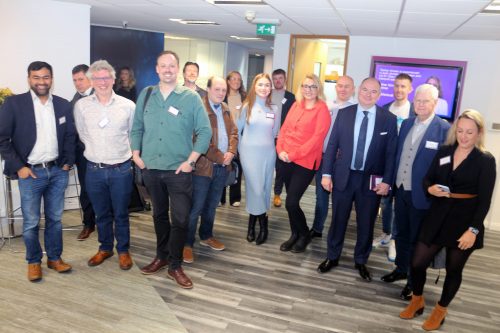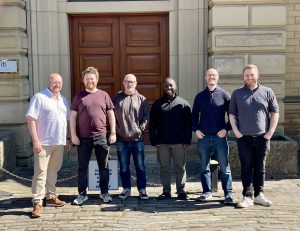Innovators share learnt insights into effective disruption

Disruption, by its nature, redefines industries. Although often associated with technology, disruptive strategies depend as much on innovation, creativity and agility.
At the Disruptors round table, sponsored by Clarion, BHP and SPG, we asked founders and leaders of innovative companies to share their insights at various stages of product development to help explore the underlying approaches to disruption.
We first asked founders and inventors how they developed and refined an idea to create a viable product.
Georgina Fairhall, founder of WAC, whose app tracks shifts and payments for shift workers, helping them manage their budgets and check they’ve been paid properly, said she used personal experience to develop the initial idea.
“I used to track my hours on paper and on my phone,” she said. “I got sick of being underpaid and not having any support and not being able to manage anything. I realised it was happening to hundreds, thousands, if not millions of people, so I got to work and started drawing what I thought would be a good app.
“It’s been a long journey. It’s about understanding the consumer, and looking at my own experiences has been really important for me.”
Ben Diamant, head of products at Aire Innovations, routinely develops new products for clients.
“Everything starts with the end user,” he said. “Talking qualitatively with as many end users as possible is priceless. All the market data is helpful, but at the end of the day have you spoken to those end users? Do you know how they feel, how they use their products, try to live their lives?
“Then lots and lots of thinking and hard work and ideation and creativity and talking to lots of people, then the design and the funding and more hard work. But start with the consumer.”
David McKee, managing partner of Counterpoint Technologies, pointed out that listening to customers could completely change your business plan. He described a medtech firm he worked with given a new testing route by a clinician.
He said: “They could shave five years off their go-to-market plan, and they don’t need investment. Their entire model changed, they could go to market in two months. And they would never have come up with it if they hadn’t talked to many people.”
One of the key pillars of developing disruptive strategies is gathering and analysing data and using that to inform decision making. We asked our leaders how much they used data to develop their ideas.
Philippa Barber, account manager at digital marketing platform Campaigner, which has access to a large amount of data, said data drove the vast majority of decisions, but she estimated gut feeling still accounted for around 15% of decisions.
“You have tech teams who come forward and say ‘this is what we’re designing,’ and I haven’t heard one user ask for it – but I can see [from the data] that they would use it. That’s the point at which I can go and announce a new feature set.”
Jimmy Forrester-Fellowes, founder of specialised dating app company Rocketware, used data to see how his apps were performing against rivals in detail, and to understand the market.
He said: “Where do my apps rank for data in London, or in Leeds? Who’s above me, and how much traffic do they get in? There are a lot more tools today than there used to be. There are tools available to see what your competitors are doing, how much traffic they’re getting and probably how much money they’re earning as well.
He added, “I also use data to drive decisions on which markets to explore. I realise why it’s actually costing me money to service some markets. Perhaps I need to price different markets differently because they’re not converting as well. So I can use that data to inform what I should be charging people.”
Lalit Suryawanshi, founder of Itecho Health, which makes digital health applications to support treatment of chronic diseases, said his firm built a prototype to help them gather data and make changes before launching their full product. Talking to clinicians had proved less reliable, he said, as they could rarely express what they wanted.
“We came to the view that we have to build something, show it to them and then go back and change it,” he said. “We used data in terms of coming up with the product, with the features, but not investing in the full thing because then it’s too late to change it.”
This, Ben Martin, chief operating officer of data encryption company S4Encrypt, was a key disruption strategy. “The idea is to fail fast, then learn and go again, and keep that process going. That’s how our product has evolved over the years.”
David McKee questioned how many companies actually used data effectively.
He said: “I think we probably all agree that one should, but when I think of all the different companies I work with, some of them very big ones, most of them don’t. That’s the reality. Most of them don’t use data, or they might do at the beginning but there isn’t a robust mechanism for putting out a roadmap.”
The marketing sector has become very data driven, but Georgia Halston, founder of specialised B2B marketing agency The Halston Group, which works with heavy industrial firms, tech companies and sustainability specialists, did not always find it useful.
She added: “The landscapes that manufacturers have to deal with, the external factors change all the time. In terms of trying to really pin down any kind of data that’s going to help me understand my market or help my clients understand their markets, the things we deal with can’t be data led because it’s out of date the next day.”
On the other hand, Steve Adams, founder of retailer Mattress Online, found data a real boon to his business. When he started his firm 20 years ago, the data did not exist.
“Now we have so many data points,” he said. “We’ve got in process 50 conversion rate opportunities, and we have to try to evaluate which is the right one to use. We try to do it on a cost basis, trying to figure out which ones are going to add most value or save the most time or add to the bottom line. It makes us really happy to have this level of data, and marketing data, and the opportunity to speak to our customers directly.”
Jonathan Simms, partner at law firm Clarion, asked Adams if the data had ever caused him to pivot his business.
Adams said it had. After noticing an uptick in sales at certain points, he realised customers were going to physical stores to see products then ordering online. As a result, he had opened physical stores.
“We’re about to open in Doncaster, for instance,” he said. “We know we’ll get a 50% uplift in our online sales in a territory just by having a physical presence in that town, as well as the additional incremental customers.”
Dean Pearson, tax partner at accountancy firm BHP, said his firm was using data more and more.
“We’re on the journey of collecting data. We record every six minutes of time we spend doing things, and use that to make better decisions from a business point of view, which enables us to do better things for clients, which is helping their business grow.”
Malcolm Wallis, founder and managing director of cloud-based compliance management provider C365Cloud, is looking to AI to take data analysis further.
“We’re looking to use predictive analytics in order to tell our clients what’s going wrong, where it’s going wrong, but also predict when it’s going to be going wrong. The AI technology that’s around is actually enabling us to do that.”
This is the first of two articles from the Disruptors round table. The second looks at practical methods of cultivating other disruptive strategies, particularly developing and maintaining business agility.









